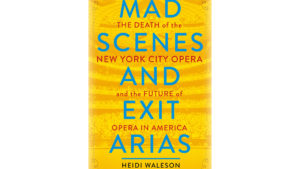
What Happened to New York City Opera? Heidi Waleson Answers That Question in New Book
By Greg WaxbergHeidi Waleson knows that, sometimes, the same idea that one person considers thought-provoking doesn’t resonate with anyone else. So, she was grateful for a book publisher’s green light to tackle a question that was eating at her: What caused New York City Opera’s demise in 2013?
“You don’t always get the chance to chase down things you really want to know,” she says.
Opera critic for The Wall Street Journal for 25 years, Waleson has written her first book, “MAD SCENES AND EXIT ARIAS: The Death of the New York City Opera and the Future of Opera in America (Metropolitan Books).” Her perspective of City Opera’s artistic side comes from over three decades of attending and then reviewing their performances.
And the operational side? “What I knew, and what I thought I knew, were the tip of the iceberg. As a reviewer, I was not privy to the intimate financial and leadership issues, but I knew what was reported in the press and I knew what I was seeing on stage. I looked at the artistic trajectory of the company and saw how severely it was declining.”
While comprehensively researching this book, which included combing through a scrapbook filled with her reviews to remind herself of what she had written, Waleson discovered not only a downward trend among productions, but also befuddling behind-the-scenes details about the company’s management. Its business model wasn’t working, and it was in serious financial trouble, but, rather than deal honestly and practically with its problems, the board seized on stopgap measures and pie-in-the-sky rescue schemes.
Yet, a decline is one thing. Filing for bankruptcy and folding completely are another. “I couldn’t believe it,” Waleson says of the company’s shocking news in the fall of 2013, which prompted her desire to write the book. “City Opera had been on a roller coaster over the years, but it had always survived, like ‘the little company that could.’”
She was on a mission and started to research and write in 2014. “It’s a really, really important company that had a very distinguished history and a very important legacy, but it had died so precipitously . . . it was important to figure out why.” And she had a secondary mission: “Was it a case that this company couldn’t survive because there was something wrong with it, or did things happen to New York City Opera that were also happening in other places?”
One problem with the company was its identity—specifically, an identity crisis, considering that City Opera was founded as a less-expensive alternative to the Metropolitan Opera. “Once that identity of ‘not the Met’ was no longer a real alternative, because times had changed, they never found another alternative,” Waleson says. Simply put, the question of City Opera’s purpose proved difficult to answer.
Another problem was inefficient oversight by New York City Opera’s board, which Waleson hopes will serve as a lesson for others in management. “Governance of artistic institutions is incredibly important. People on the boards of non-profits have a big responsibility and need to look carefully at what their companies are doing. If something is not going well, dig in to figure out why.”
For the opera-going public, Waleson wants them to know that the art form continues to be viable, evidenced by City Opera’s relaunch in 2016. “There still are ways to produce opera and attract audiences. There’s a future . . . producers have to figure out how to make it work.”
Though the book’s birth was difficult and exhilarating, Waleson is pleased. “Writing an institutional history could be dry, but I was so excited when people told me it’s a ‘page-turner.’ It’s an important story. I’m glad I wrote it.”
Categories
Special Features

